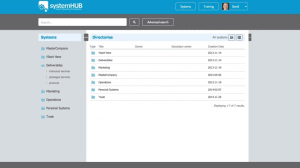For most businesses, you need key systems in finance, human resources, sales and marketing, and operations.
Watch this video to learn 5 steps you can follow to better improve systems within your business.
Go over the 5 key steps to develop your business systems.
- List out all your systems
- Create a system for systems
- Document core systems
- Centerally store systems
- CANI principle, constant and never ending improvement.
In this video we go into these in much more detail. Watch below.
Interested in learning more from systemHUB live workshop? Sign up today for your free systemHUB trial – click here.
Video transcript:
Step one is listing out all the possible systems. It’s a little like doing a brain dump to get it our of your head. That’s quite freeing. It’s like Getting Things Done. Has anyone read that book by David Allen? One of the strategies he goes through first is just to get the brain dump, get it out of your head, so that way you don’t have to think about it.
The next step is to create the first system which is the system for creating systems. I know it sounds a little bit funny there. It is a process by which you document and create your own processes and procedures.
I’ll give you mine, so you don’t even have to design yours. This will be the first system. I haven’t yet prettied up the site, but it does what it needs to. It’s got a name and an email address. You can head to system for systems and I’ll email you a pdf of our system for creating systems.
The reason you start with that one is it is what you can give a team member to start to document your processes and procedures. Even though I like detail, I’m really not a detail person. I’m a bit OCD, I understand that. I don’t like doing it, but it has to be done a certain way.
One of the first tasks for the way we create systems is I’ll record myself or a team member doing the task. That is step one in architecting a system, to record you doing it. Then you can pass it to another team member who will then start to document the processes and procedures behind you. It makes it a very easy way for you to do it.
As a business owner, you say, when am I going to find time in the day to do systems when I’m having trouble just dealing with my day to day clients? Who is going to have time in the day to make systems, just like Dave said? So using the system for systems will help.
That leads to step number three. That is getting your core systems in place. It’s important to not go too hog wild with this. You don’t need a system to take out the rubbish. You don’t document absolutely everything in your business. Find the core functions that are the most important and start with those first.
Often I think, what don’t I enjoy, what is repetitive, what could be easily delegated? Typically speaking, the

Organized ingredients
things you create systems for last, are things that surround your unique ability. So if you’re a graphic designer, it’s you doing the graphic design elements. If you’re a web designer, or whatever you are, that is usually the last section. Try to create systems around everything else first and then you can move to that.
I’ll use Mike as an example. Mike is a systems guy as well. He gets systems way back when from E-Myth days. They are firmly in his mind. When he really started getting systems in place for his business, he went completely the other way and systemised everything.
I remember you talking about the fact that created a bit of a challenge for the team to use the systems and find the systems when they wanted them. It was over documentation. Even though once you get excited about systems, you just want to make sure you approach it by picking the most important ones and the ones that are going to have the biggest impact. You don’t need a system for everything.
Then we move to step four in the five step process. This is to have it centrally stored. We used to use Dropbox. We used to use EditMe, GoogleDocs. I’ve tried them all. They’ve all got their problems, to do with permissions and sharing and a whole bunch of different things.
So much so, we ended up designing our own solution called SystemHUB. That’s where we store all of our standard operating procedures. At the moment it is still in the beta phase. I’ll be around for the rest of the day and if you’re interested in being one of the early beta testers, hand me your business card and I can follow up and give you some access to this.
It doesn’t really matter what you use, as long as you’ve

systemHUB
got something in place. Maybe you just start off with Dropbox. Then you have a central place where you store your processes and procedures. By having it centrally stored, you’re getting your team into the system mindset. You want to get them to apply the CANI principle. Are there any Tony Robbins fans? What does CANI stand for, does anyone remember? Yes, Constant And Never-ending Improvement or Innovation. That’s really where the value of systems comes from.
We talked about it being a valuable business asset. Where the true value comes is when the team uses them and they continue to improve them and optimise them. They’re making little tweaks. They say, this can be done better this way now. So it is a wax on, wax off approach.
There are the five steps. List the systems that you could potentially have in your business. Create a system for systems, or you can swipe mine, over at systemforsystems.com. Document your core processes, the ones that are the most important, have them centrally stored and then apply the CANI principle.
There are probably just a few hurdles that you might come up against that you need to overcome. The biggest one is you know systems are important now, but it is not urgent. So it is easy for you to delegate. But for the right person, there are some easy ways you can hack this, if you think I don’t have time to do systems.
The first one is to apply the KISS principle. Keep It Simple Simon. You want to keep it as simple as possible. Start off by using video to document the first go at the procedure.
Once you’ve got that, if you’ve got the system for creating systems, you hand that to a team member and they create the documentation behind you. Just keep the systems very basic for now. They can evolve over time, just have basic checklists.
Does any one know the secret for making systems super easy? The easy way is just not to do it. What you could potentially do is delegate it. Make it the responsibility of a team member inside your business to start building out the processes and procedures. So if you’re really getting stuck, delegate it down the line.
I’ve got a friend who gave me fantastic nugget of information. He’s built multiple eight figure businesses. He told me this it’s genius. If you’ve got a bit of a budget and you’ve got a sizeable business that can handle it, you go out and hire the consultant.
Find the expert in that particular area, the guru for accounting or the guru for sales. Get them to come in and you pay them to create your processes and procedures. That becomes an asset within your business. You don’t have to create it and then your team can start following it behind you.
Are you ready to implement these systems in your business too?
Don’t delay sign up today for your free systemHUB trial click here.










